The Dell Venue 11 Pro 7000 Review
by Brett Howse on April 16, 2015 8:00 AM EST- Posted in
- Tablets
- Dell
- Windows 8.1
- Core M
Display
Much like a smartphone, the display of a tablet is one of the most critical elements. Not only is it the only method of receiving information, it is also the primary method at input. A mediocre tablet can get by with a poor display, but unlike laptops the bar for poor displays on a tablet is much higher. A good tablet needs a good display, and Dell has delivered here.
The Venue 11 Pro is equipped with a Samsung SDC4C48 panel, which is an 8 bit model. The 10.8 inch panel is 1920x1080, for a good 204 pixels per inch. While not class leading in pixel density, everything looks clear and sharp. It is also a good compromise for desktop use, where you can pretty easily get by with just 125% scaling to keep a reasonable amount of desktop real estate available.
Dell Venue 11 Pro Pixel Arrangement
The Samsung display is a full RGB stripe, so there is no question about subpixel density like on a RGBW pentile arrangement. Color accuracy is generally better as well with RGB, and to test that, we will turn to SpectralCal’s CalMAN 5 suite, along with an X-Rite i1Display Pro colorimeter for brightness and contrast measurements, and the X-Rite i1Pro spectrophotometer for color accuracy testing.
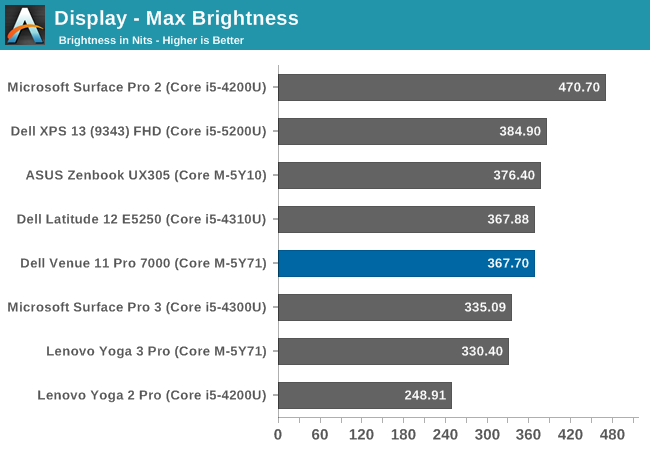
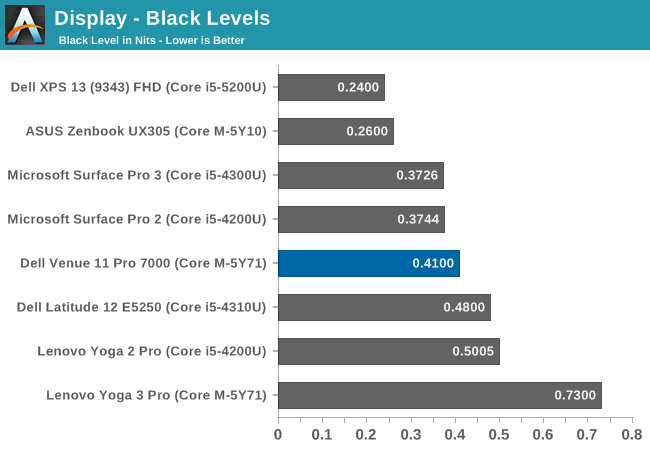
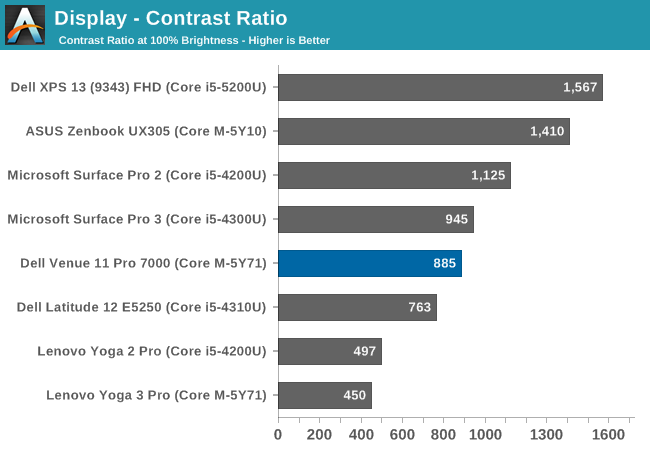
Dell’s premium Windows tablet starts off quite well, with good brightness at about 370 nits. The black levels are just OK though, which results in a good but not spectacular 885:1 contrast ratio. For those that need a dim display for use in a darker environment, The Venue 11 Pro goes down to around 18 nits so it should be no problem there.

Looking at grayscale, the Venue 11 Pro has not too bad of a score out of the box, but it could use some work. Overall the dE2000 is 4.38, which is due to the greens being a bit too strong, and the gamma falls off of the 2.2 target especially at the upper brightness levels. The white point is good overall though at 6615, very close to the ideal target of 6504.
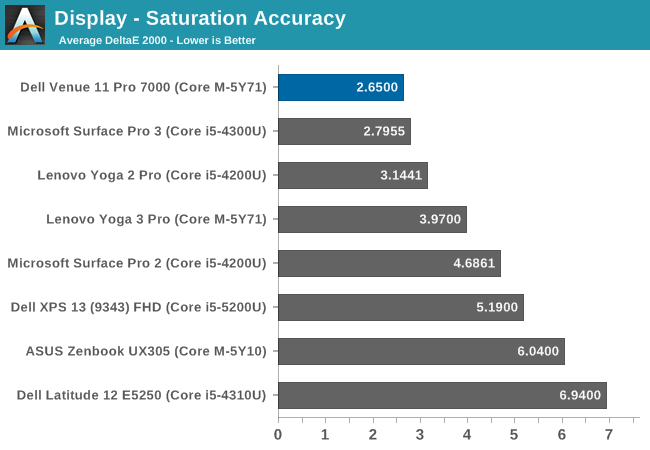
The saturation sweep is excellent, with an overall dE2000 of just 2.65, nicely under the target score of 3.0. The reds are a bit compressed though, and the 100% red is closer to 80% than 100%. The other colors are very close to their targets though.
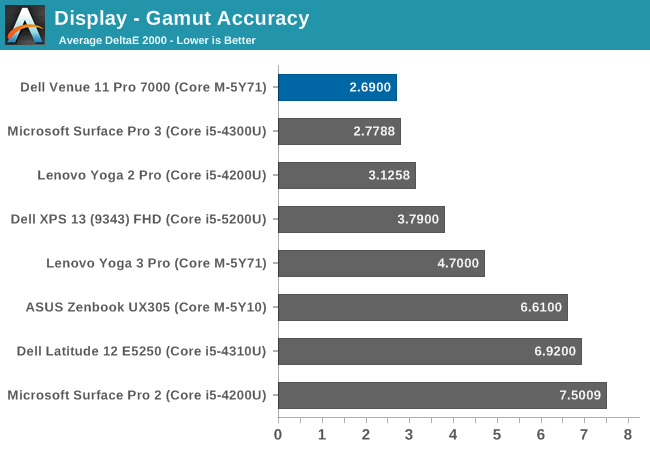
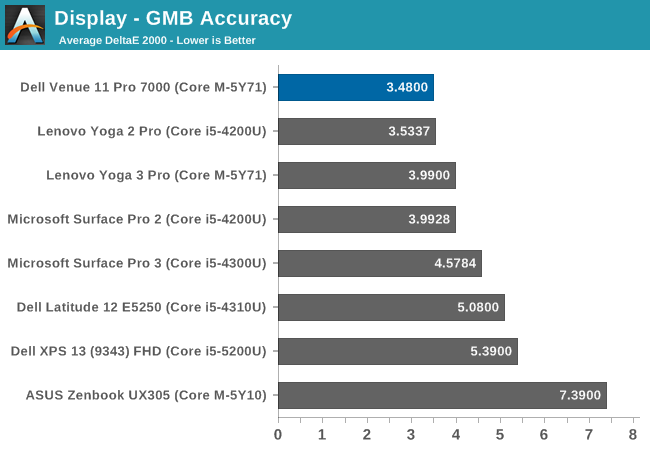
The Gretag MacBeth colorchecker is the most comprehensive test, and the overall score is 3.48, which is just above the 3.0 target. For an out of the box experience, few would complain about the Dell Venue 11 Pro tablet. Colors are generally quite good, and the brightness and contrast is also good.
Being a Windows tablet, we can also calibrate the display. Since the worst offender was the grayscale performance, calibration should help a lot to pull those scores down.
Once calibrated, this display is almost perfect. The grayscale falls to 0.71, and the gamma is almost spot on. Gamut falls to just 1.41, saturations are 0.83, and the GMB score drops to 1.13. Out of the box, the display is already good, but once calibrated it is fantastic.
Few would be left wanting with the Venue 11’s display. It has the kind of quality display one would expect in a premium tablet. Color accuracy is good out of the box, but because it is Windows it can be improved upon assuming one has the tools to do so. Really the only issue I had with the display is the 16:9 ratio, which works great for media consumption like MLB.TV and the like, but a taller overall display would make it a better tablet for both portrait and landscape modes.


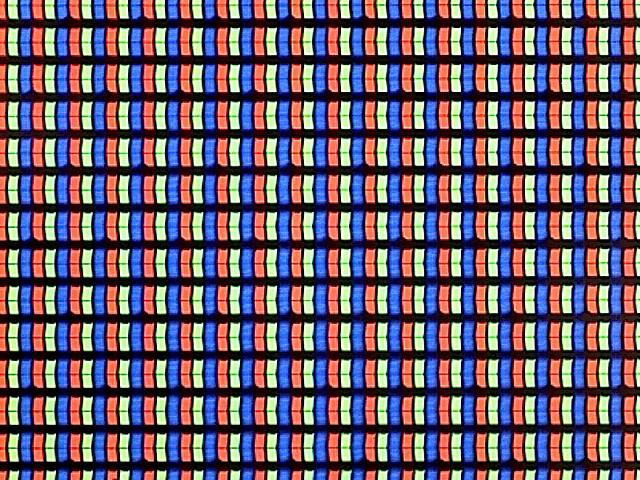
















92 Comments
View All Comments
thunng8 - Friday, April 17, 2015 - link
A8X in the iPad Air 2 does ~1820 in single threaded geekbenchTrackSmart - Thursday, April 16, 2015 - link
This seems like an overly strong statement ("horrible!" -- for the price).Core M is a low-power platform. For standard office productivity tasks, it provides similar performance to 15 watt ultrabook processors, but only uses 4.5 watts of power. That's pretty impressive. I don't see where the "horrible" part comes into play. These are meant to be ultramobile parts. The laws of physics dictate that there will be some tradeoff between power consumption and performance when you are constrained by thermal limits and battery capacity.
-If you don't like Core M, choose a product built around a higher TDP platform and move to the other side of the curve (higher power consumption, but also consistently higher performance in continuous workloads).
-If you want a snappy system for standard office productivity tasks in the most mobile form-factor possible, choose a Core M product, and enjoy similar performance to 15 watt parts for "burst" oriented workloads, but in a thinner, lighter, longer-lasting form factor.
-If you want a cheaper price point, choose a slower product built around an Atom processor, which will offer a similar form factor but lower performance.
-And if you can live without Windows, sure, buy an ARM-based tablet.
** It's fantastic that we have these choices today. ** If your problem is the price of Core M, well, unfortunately we are talking about full-on Core architecture processors. Without greater competition, Intel isn't going to give these processors away at Atom prices. And especially not at ARM prices.
As for this particular product, I agree it does't look very "premium" to me, either, that has nothing to do with the Core M processor inside. I'm personally impressed with what Asus did with the UX305 for $699 and a Core M processor. Solid ultra-portable performance in a very thin chassis with long battery life.
Didn't mean to jump on you here. Just sort of surprised that anyone would call Core M itself horrible. Many people have been waiting for this kind of performance in such a low TDP x86 processor.
Qwertilot - Thursday, April 16, 2015 - link
Apple have the resources that they presumably could (more or less) match the CPU single core of this, but I don't think putting so much single core performance into a tablet chip is what you'd chose to do if designing specifically for tablets.Especially with Apple being very keen on having lots and lots of graphics firepower to hand.
CoreM's design makes much more sense if you're going for fanless notebooks, at times with the cooling systems around to run it at somewhat higher power than you'd want for a tablet etc.
Marc GP - Thursday, April 16, 2015 - link
Sorry, but no. Core M doesn't gives you the performance of a 15w ultrabook using only 4.5watts.Because it can only give you that for short bursts before seriously throttling and having to lower its clock from 2,8Ghz (turbo) to its nominal 1Ghz frequency, the only one they can keep for large periods.
Don't try anything that needs steady performance on a Core M, like gaming, for example.
TrackSmart - Thursday, April 16, 2015 - link
I don't mean to be rude, but I don't think you read my post or the article itself very carefully. My post says that for typical office productivity tasks, which are burst-oriented, you get similar performance. I also say that if you want sustained higher performance, you need to move to a higher TDP. The article says similar things and shows benchmarks to demonstrate this. So what exactly are you arguing that I didn't say myself?My Post:
"For standard office productivity tasks, it provides similar performance to 15 watt ultrabook processors, but only uses 4.5 watts of power. ...choose a Core M product, and enjoy similar performance to 15 watt parts for "burst" oriented workloads, but in a thinner, lighter, longer-lasting form factor."
Article: In the PCMark 8 section, which simulates office productivity tasks -- "In these types of workloads, Core M can outperform [15 watt TDP] Haswell-U series parts from the Ultrabooks of last year, which is fairly impressive in a passively cooled device."
To "jjj", you still haven't provided a sensible argument. I'd love it if Intel sold these chips for $50, but it isn't going to happen. You'd have to be living on another planet to think otherwise. Until someone else offers similar x86 CPU performance in a comparable power envelope, these products are going to command prices that are similar to Intel's other Core series processors.
jjj - Thursday, April 16, 2015 - link
It's the worst chip in history!! lolLet me explain why and remember i said horrible for the price.
Die is about 80mm2 so similar to the Exynos 7420 and 50% smaller than a Snapdragon801. Sure it comes on a module so that adds to costs a bit but Intel launched it at some 280$. Even if an OEM would pay 3 times less ,the chip would still cost way way too much. Mobile chips that size sell for 15-30$ depending on how new they are (start at 30 and keep dropping during their lifetime), IHS just a couple of days ago estimated that the Exynos 7420 costs 29.5$ ( to buy not to make).
So Intel here is just abusing it's x86 monopoly and charging absurd prices for the chip. That's why we don't see tabs like this one at 300$ and why the chip is horrible. If it was below 50$ it would be fine but it's a hell of a lot more.
PS: you can check die size and price in one of the early articles on Core M here on AT.
jjj - Thursday, April 16, 2015 - link
Correction- Meant to say that SD801 is 50% bigger or Core M is 33% smaller than SD801 and ended up with something else.smilingcrow - Thursday, April 16, 2015 - link
Translation. It's a great chip but I can't afford it and I'm so very very angry.jjj - Thursday, April 16, 2015 - link
Not even a trace of anger ,i know Intel's ways too well for it's behavior to impress me and i can afford it but i'm not that stupid to buy it (not that i need it to begin with).Anyway , thanks for your valuable contribution to the conversation , it was a true delight.
akdj - Saturday, April 18, 2015 - link
Excellent words 'crow. I'm thinking jjj doesn't understand X86, ARM, and bigLittle architecture NOR how a mobile processor is 'of benefit' to MOST people in today's world. They're as fast as the core i5 power in SB, close to IB and even with thermal limitations, it smokes the Intel iGPU 4000. I'm ambidextrous, using OS X and Windows Android and iOS. To exclaim 'the worst chip in history' considering where Intel was just 18 months ago VERY WELL be the MOST ignorant statement I've seen on Anand's site in some time. Regardless of price (remember, R&D must be recouped to bring the archtiecture's price down), and the magic Apple's done with 64 bit processing over the past two years, it's Qualcomm that's been blindsided. Samsung has switched to their chips, has the A9 contract and have settled disputes everywhere but America. The power of samsung and Apple's engineering prowess and chip trickery (A8x and A8, second and 2.5 gen 64bit chips are nearing a year old, as they start production early summer on the fall iOS releases), it's Intel and Apple/Samsung and TSMC. What the A8/A8x did for the iPad Air 2 is. Itching short of incredible and as an owner for almost nine months, I'm confident there are very few folks in this world that need 'more power' than iPad Air2, Nexus 9, or this Dell reviewed. Most of us that 'work' with a company supplied computer don't really feel like desktops when we get home. Don't have time with the kids and it's easy to throw in the truck and forget about the charger! Laptops are a PITA in comparison and not 'really' that much more capable ESPECIALLY if you use the tools built for and sold I the App Store. Every app of the million plus are optimized at this time for the A5/6 families of SoCs. That's the missing point here. With this Dell, the entire world of software 'Windows built' is now available to you with significantly faster storage and a mature 64bit process from a company that's led the way in silicon for thirty years. And they, like Apple, have the paper to test, retest and 'make it work'. Tegra. Tegra 3, 4 and now these ULV procs taking it to an entirely different level of performanceWith the iGPU it's a matter of efficient cooling in fabless designs to slow down the throttling. That's going to come as they continue the more efficient designs with Skylake and the future.
Just plain ignorance. So sad with all these power packed choices we've got now, their time is limited. Not enough room for a half dozen silicon manufacturers. 2, maybe three will win out and my bets on ARM, Intel and possibly Sammys Exnyos